 Exhibitions Archive
Exhibitions Archive
 Exhibitions Archive
Exhibitions Archive

AZ32. Annunciation
Central Russia, first half of the 17th century.
Dimensions: 65.6 x 46.5cm; thickness 3.6cm![hideselects= [On] header =[Convert size] body = [Click here to show the size in inches] Click here to convert metric size to imperial](images/inches.gif)
Inscription: in Slavonic on the upper border, Благовещение (Annunciation)
Provenance: Amsterdam, from the collection of Loek Caspers. Loek Caspers was a Dutch Resistance fighter during the Second World War who helped many Jewish children and resistance fighters. She worked as a maternity nurse which allowed her to retain a bike, which she used to transport weapons and help communication between resistance cells. She went on to train as a doctor in England and died in 2019, being one of the last surviving members of the Dutch Resistance.
Feast Day: 25th of March

Proceeds from this icon sale will help the Sister Mura Foundation in Johannesburg. The Foundation assists migrants living with HIV/Aids by providing income generating schemes. They also provide educational bursaries, helping eighty families to pay for primary, secondary, and higher education.

No. 32. Detail. The Rhythm and thrust of the abstract architectural forms presages the Russian Avant Garde of the early 20th century.

No. 32. Detail.
Icons of Gabriel’s Annunciation to Mary date from the third century. One fresco of the subject, in the Roman catacomb of Priscilla, is thought to be second century. The imagery is based partly on Luke (1:26-38) and the apocryphal Protoevangelion Jacobi or Book of James (11:1-3), which dates from the second century. The latter was the source throughout the Middle Ages for much of the imagery associated with Mary, both in the East and West. Today it is little known other than to scholars. According to this apocryphal tradition, Mary was one of seven virgins set to spin wool. For each a different colour was chosen by lot and that of royal purple fell to Mary. It is said that this was the skein of wool that would cover the Holy of Holies in the Temple and which would be ‘rent in twain’ at the Crucifixion. Gabriel’s actions, though painted with the proper restraint typical of icons, are specific: the feet show that he is in movement − he is a messenger − and his right hand blesses Mary.
The iconographic tradition denotes three separate events comprising Mary’s reaction to the news. First, her perturbation: she turns away from Gabriel and raises her hand as though to ward him off. Second, her perplexity and prudence: she turns towards the angel but does not yet accept (‘How can this be, seeing I know not a man?’) Third, her consent: here we see her right hand raised in a gesture of acceptance while her head bows in assent (‘So be it’.)
The background includes Mary’s house (one thinks of the Philokalia’s ‘house of spiritual architecture’) with its doorways and entrances. She sits enthroned, and her feet do not touch the ground but rest on a footstool. The archangel, whose movement is in contrast to her repose, has suddenly appeared as though from the divine realms. The non-realistic architecture reminds us of the event’s supernatural meaning. In this example the mannerisms derive from a Palaiologan model of the Annunciation. Such icons show the innate talent of Russian icon painters at this time. Often icons such as these were reproduced using models from the Russian icon painting schools at Rostov, Novgorod and Moscow. As noted for No. 29 in this catalogue, the energy of the abstract architectural forms seems to presage the Constructivist painters of the early twentieth century.
Fig. 1. Back of Panel